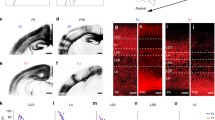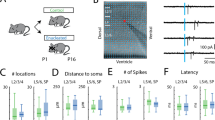Abstract
The pyramidal tract, comprising those axons which pass from the neocortex to the medulla and spinal cord, is among the most thoroughly studied projections of the mammalian cortex. Recent studies using anterograde axon tracing techniques have provided information concerning the time course of the growth of pyramidal tract fibres1,2, yet much remains to be learned about its development. We have now begun to study the distribution of the neurones of origin of the pyramidal tract during the postnatal development of the rat neocortex using the recently introduced retrogradely transported fluorescent marker, True blue3. During the first postnatal week, injections of True blue into the pyramidal decussation result in the labelling of pyramidal tract neurones which are distributed virtually throughout the tangential extent of layer V of the neocortex, whereas after comparable injections during the fourth postnatal week the distribution of such cells is much more restricted and remains restricted into adult life. This developmental restriction is most dramatic in the occipital cortex: during the first postnatal week many pyramidal tract neurones are found throughout the visual cortex while none is seen in this area in the adult. When True blue is injected into the pyramidal decussation during the first postnatal week and the animals are allowed to survive until the fourth postnatal week, the distribution of pyramidal tract neurones is as widespread as in the immediate postnatal period and includes the entire visual cortex. This implies that many of the neurones in the occipital cortex initially send a collateral into the pyramidal tract which is later eliminated, although the neurones themselves persist. These findings, together with similar recent observations on the development of the callosal connections4,5, indicate that the elimination of axon collaterals may be a general feature of the development of cortical projection systems, and that such transitory collaterals may traverse considerable distances.
This is a preview of subscription content, access via your institution
Access options
Subscribe to this journal
Receive 51 print issues and online access
$199.00 per year
only $3.90 per issue
Buy this article
- Purchase on Springer Link
- Instant access to full article PDF
Prices may be subject to local taxes which are calculated during checkout
Similar content being viewed by others
References
Reh, T. & Kalil, K. J. Comp. Neurol. 200, 55–67 (1981).
Schreyer, D. J. & Jones, E. G. Neuroscience (in the press).
Bentivoglio, M. Kuypers, H. G. J. M., Catsman-Berrevoets, C. E. & Dann, O. Neurosci. Lett. 12, 235–240 (1979).
Innocenti, G. M. Science 212, 824–827 (1981).
O'Leary, D. D. M., Stanfield, B. B. & Cowan, W. M. Dev. Brain Res. 1, 607–617 (1981).
DeMyer, W. Archs Neurol. 16, 203–211 (1967).
Valverde, F. J. comp. Neurol. 119, 25–54 (1962).
Wise, S. P. & Jones, E. G. J. comp. Neurol. 175, 129–158 (1977).
Sawchenko, P. E. & Swanson, L. W. Brain Res. 210, 31–51 (1981).
Catsman-Berrevoets, C. E., Lemon, R. N., Verburgh, C. A., Bentivoglio, M. & Kuypers, H. G. J. M. Expl Brain Res. 39, 433–440 (1980).
Catsman-Berrevoets, C. E. & Kuypers, H. G. J. M. Brain Res. 218, 15–33 (1981).
Woolsey, C. N. in Milbank Symp. on the Biology of Mental Health and Disease, 193–206 (Hoeber, New York, 1952).
Montero, V. M. Brain Res. 53, 192–196 (1973).
Ivy, G. O. & Killackey, H. P. J. comp. Neurol. 195, 367–389 (1981).
Purves, D. & Lichtman, J. W. Science 210, 153–157 (1980).
Johnson, D. A. & Purves, D. J. Physiol., Lond. 318, 143–159 (1981).
Author information
Authors and Affiliations
Rights and permissions
About this article
Cite this article
Stanfield, B., O'Leary, D. & Fricks, C. Selective collateral elimination in early postnatal development restricts cortical distribution of rat pyramidal tract neurones. Nature 298, 371–373 (1982). https://doi.org/10.1038/298371a0
Received:
Accepted:
Issue Date:
DOI: https://doi.org/10.1038/298371a0
This article is cited by
-
Untangling the cortico-thalamo-cortical loop: cellular pieces of a knotty circuit puzzle
Nature Reviews Neuroscience (2021)
-
Transient callosal projections of L4 neurons are eliminated for the acquisition of local connectivity
Nature Communications (2019)
-
Roles of axon guidance molecules in neuronal wiring in the developing spinal cord
Nature Reviews Neuroscience (2019)
-
Mechanisms of developmental neurite pruning
Cellular and Molecular Life Sciences (2015)
-
Brain Development During the Preschool Years
Neuropsychology Review (2012)
Comments
By submitting a comment you agree to abide by our Terms and Community Guidelines. If you find something abusive or that does not comply with our terms or guidelines please flag it as inappropriate.



